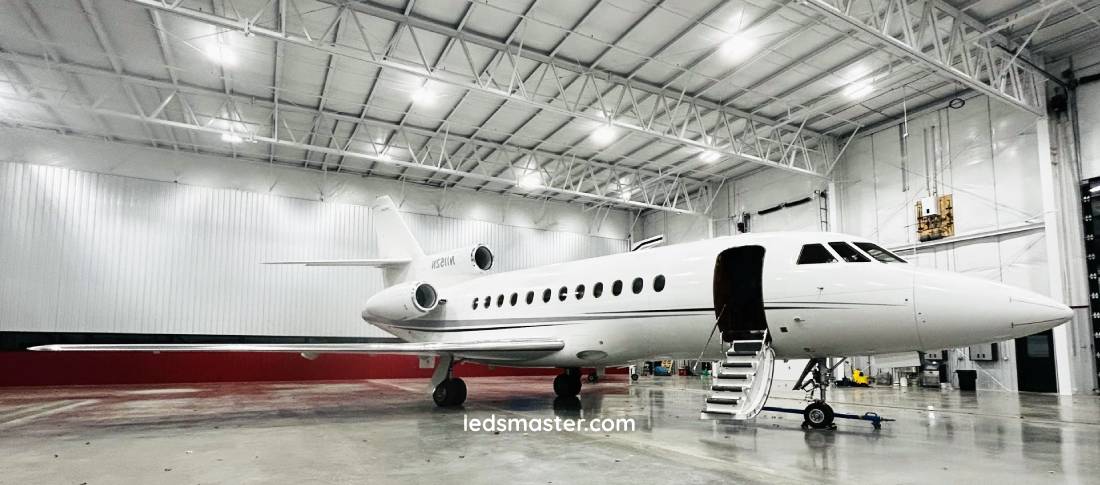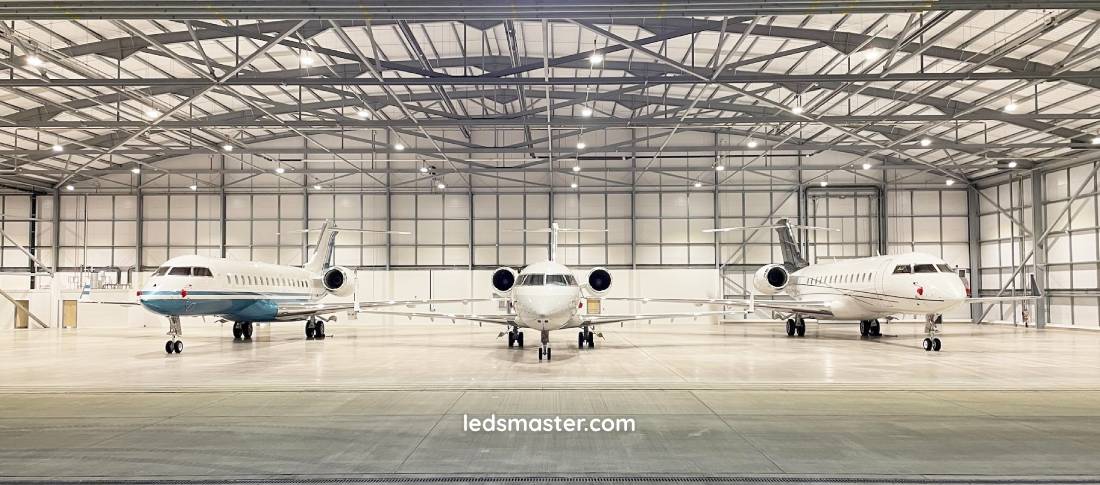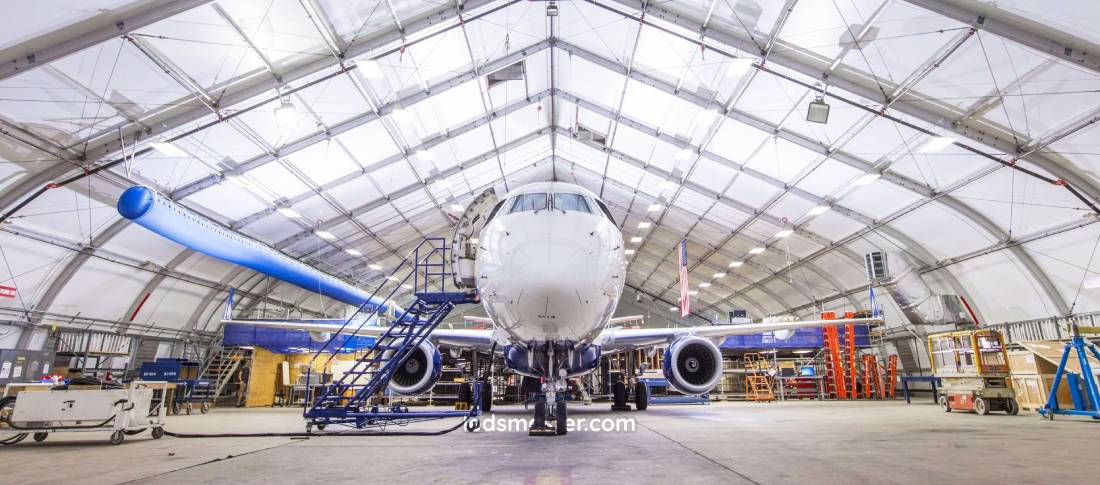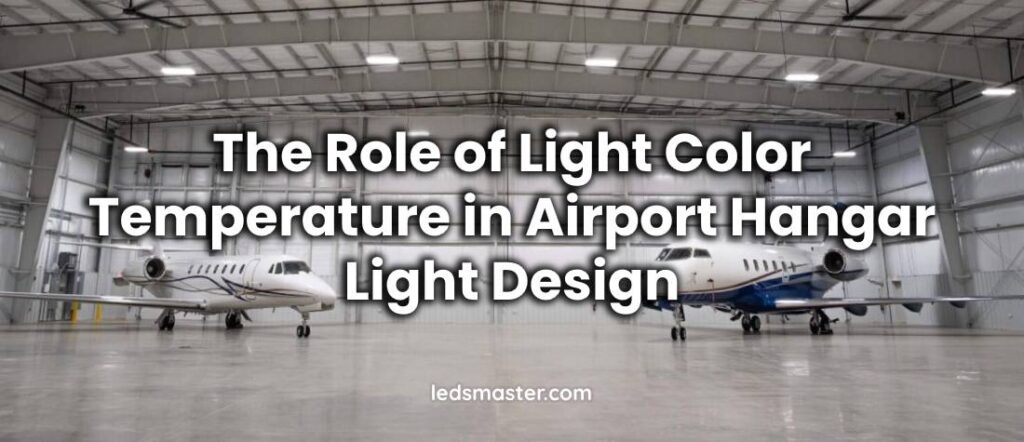One key factor in designing lighting systems for hangars is the color temperature of the light. Color temperature, measured in Kelvins (K), refers to the warmth or coolness of the light emitted by a bulb. Airport hangars, with their large spaces and diverse activities, require careful consideration of how light color temperature can influence the environment and the tasks being performed.
The color temperature of the lighting in a hangar influences various factors such as visibility, energy consumption, worker comfort, and overall productivity. Depending on the types of tasks being performed, different areas of the hangar may require specific light qualities to ensure the most efficient and effective operations.

Table of Contents
ToggleUnderstanding Color Temperature
Color temperature is a key concept in lighting design that refers to the appearance of light emitted by a source, describing whether the light is warm or cool. It is measured in Kelvins (K), with lower values producing warmer, yellowish light and higher values emitting cooler, bluish light. The range of color temperature typically spans from 2700K to 6500K or higher, influencing how light appears in different spaces. For example, a standard incandescent bulb typically has a color temperature of around 2700K, producing a warm, yellowish glow. On the other hand, daylight, which has a cooler, bluish tone, ranges from 5000K to 6500K.
The color temperature of lighting plays an integral role in shaping the atmosphere of a space and enhancing the functionality of different environments. In airport hangars, a carefully chosen color temperature is fundamental to ensuring the effectiveness of various tasks. A hangar is a large, specialized space that requires lighting systems that can support diverse functions, ranging from highly detailed aircraft inspections to routine administrative work. For example, areas where detailed maintenance and inspection work take place would benefit from cooler, daylight-like color temperatures, whereas more relaxed areas, such as offices or storage rooms, might benefit from warmer lighting to promote comfort.
Hangar lighting, when optimized with the right color temperature, can help increase visibility, reduce fatigue, and improve operational efficiency. The specific needs of the space must be taken into account, whether for precision-oriented tasks like aircraft maintenance or more general functions. Tailoring the lighting system, including color temperature, ensures that each section of the hangar is adequately illuminated and can operate smoothly throughout the day and night.
The Importance of Lighting in Airport Hangars

Lighting for Aircraft Maintenance and Inspection
Aircraft maintenance and inspection are highly precise tasks that demand the best possible visibility to ensure no detail is overlooked. Whether it’s checking the airframe, evaluating the engine, or inspecting other components, the lighting in these areas must provide clear, sharp contrast to make sure every small defect is noticed. In the context of maintenance tasks, color temperature becomes a fundamental part of the lighting design. Daylight-like color temperatures, typically ranging from 5000K to 6500K, offer a bright, crisp illumination that closely resembles natural sunlight. This cool white light enhances visibility, helping workers to spot any minor issues that could otherwise be missed under warmer, dimmer lighting conditions.
The cool color temperature not only improves visual clarity but also fosters better focus and alertness among workers. When technicians and engineers are working under intense scrutiny, maintaining focus for long hours can be difficult. The bright, blue-toned light can help keep workers alert, reducing eye strain and helping them stay engaged with their work.
In addition to promoting visibility and focus, proper lighting also plays a role in ensuring the accuracy of the tasks at hand. Small errors in aircraft maintenance can lead to costly delays or serious safety issues, which is why the choice of lighting and color temperature is so critical. The right lighting enables technicians to identify even the smallest flaws or wear-and-tear that could compromise an aircraft’s performance.
Lighting for Storage and General Areas
Aside from maintenance zones, an airport hangar includes a variety of other spaces that require a different approach to lighting. Storage areas, break rooms, offices, and other general spaces do not require the high levels of brightness or the daylight-like color temperatures seen in maintenance areas. For these areas, a softer, warmer light is typically more suitable. Color temperatures between 2700K and 3000K are commonly used to create a more comfortable and inviting atmosphere.
Warmer lighting in these spaces helps to reduce glare, which can be disruptive or straining for workers who may be reading, organizing materials, or engaging in administrative work. The warmer tone of light also aids in creating a relaxed environment, which can promote a sense of well-being and comfort during breaks. Employees spend a significant amount of time in these general areas, and the lighting can influence their productivity and overall experience in the hangar. The softer light encourages relaxation and provides a sense of calm that is important during moments of rest or non-technical work.
Furthermore, while these areas do not require the high-intensity lighting necessary for aircraft inspection, it is still important to maintain uniform lighting throughout the entire hangar. Consistent illumination ensures that workers can transition smoothly from one area to another without disruption. The balance between functional lighting for work areas and comfortable lighting for general areas can help create an environment conducive to both high productivity and comfort.

Factors Affecting Lighting Choices in Hangars
Task-Specific Requirements
The specific tasks carried out in each part of an airport hangar vary greatly, and this diversity requires careful consideration when selecting lighting. Aircraft maintenance tasks, for example, are precision-driven, while storage or administrative work relies more on general lighting. Each of these tasks has its own light needs, and selecting the appropriate color temperature is vital for optimal performance.
For precision tasks, higher color temperatures ranging from 5000K to 6500K help illuminate fine details, ensuring workers can see even the smallest flaws. For areas that require less intense lighting, such as lounges or offices, a warmer light temperature of around 2700K to 3000K creates a more comfortable and relaxing environment. By tailoring the lighting to match the function of each area, airport hangars can ensure that every zone is equipped with the ideal conditions for productivity and comfort.
Space Size and Configuration
The size and configuration of a hangar present their own challenges when designing the lighting system. Hangars are large, open spaces that require evenly distributed light to avoid areas of darkness or shadows. The layout of the hangar, including its height and the placement of equipment, will influence the number and positioning of light fixtures.
When working in a large hangar, the lighting needs to be spread evenly across the entire space, especially in areas where work is being performed on aircraft. High ceilings, which are often found in hangars, require careful attention to ensure that light reaches the ground and illuminates the entire area without causing glare. The choice of color temperature can assist with achieving optimal coverage across the space. Cool, bright lighting is often more effective in large spaces, as it helps illuminate surfaces clearly, providing better visibility for workers without consuming excessive amounts of energy.
Energy Efficiency Considerations
Energy efficiency is a major concern for any commercial or industrial space, including airport hangars. Hangars often operate around the clock, which can lead to high energy consumption if lighting is not optimized. The selection of energy-efficient lighting sources, such as LED lights, can reduce operating costs while still providing the necessary light levels.
LED lighting systems offer flexibility when it comes to color temperature, allowing hangar designers to choose a temperature that meets the needs of different areas without sacrificing energy efficiency. LED lights consume less energy than traditional incandescent or fluorescent lights, and their longevity reduces the need for frequent bulb replacements. Furthermore, because LED lights generate less heat, they can help maintain more stable temperatures in large hangars, reducing the reliance on cooling systems.
The Impact of Color Temperature on Worker Productivity
Enhancing Focus and Alertness
Workplace productivity can be directly impacted by the type of lighting used. In an airport hangar, where workers may need to concentrate for long periods of time, the right lighting can help improve focus and mental clarity. Cool color temperatures, typically in the 5000K to 6500K range, are known to promote alertness and concentration. This is especially important in maintenance areas, where workers must remain highly focused on detailed tasks such as inspecting an aircraft’s engine or airframe.
The psychological effects of light temperature have been studied extensively, with cooler light shown to help stimulate cognitive function and mental acuity. By incorporating cool color temperatures in workspaces, hangars can support workers’ ability to stay focused on intricate tasks, increasing productivity and reducing the likelihood of errors.
Reducing Fatigue in General Areas
In areas where workers spend more extended periods, such as lounges, offices, or rest areas, the type of lighting used can help reduce fatigue and eye strain. Warmer light, generally in the range of 2700K to 3000K, creates a more soothing environment, making it easier for workers to relax and recuperate during breaks. A softer, warmer glow is less harsh on the eyes, particularly in spaces where workers may be reading, using a computer, or handling paperwork.
Balancing the color temperature between different areas of the hangar ensures that workers remain comfortable throughout their shifts. By creating a space that fosters both alertness and relaxation, hangar management can help ensure that workers stay productive and focused when performing more demanding tasks.
Light Color Temperature and Safety
Improving Visibility for Safety and Security
Safety in an airport hangar is a priority, and effective lighting plays a role in maintaining a safe work environment. Poor lighting can lead to accidents or delays, especially when workers are handling large equipment or navigating the hangar floor. A well-lit hangar can minimize hazards, improve safety protocols, and reduce the risk of mishaps.
Cooler color temperatures help with visibility, particularly in low-light conditions or during nighttime shifts. By maintaining bright, crisp lighting with the right color temperature, hangars can ensure that the workplace is illuminated to the standards required for safe operation.
Avoiding Glare and Eye Strain
While bright lighting is necessary in certain areas of the hangar, excessive glare can cause discomfort and reduce the effectiveness of lighting. For this reason, the design of the lighting system must account for how light interacts with surfaces and materials within the hangar. Using the right color temperature helps prevent glare, ensuring that workers can see clearly without being distracted by harsh or uneven lighting.
Conclusion
The lighting in airport hangars serves multiple functions, from enabling precise work in aircraft maintenance to ensuring comfort and safety for workers. Light color temperature plays a central role in how these spaces function, influencing visibility, worker productivity, and energy consumption. By choosing the appropriate color temperatures for different areas of the hangar, airports can create a space that is both functional and efficient, ensuring smooth operations and a productive work environment. The combination of technical lighting with thoughtful design contributes to a well-illuminated space that supports the demanding tasks performed in airport hangars.

